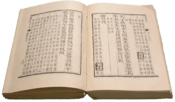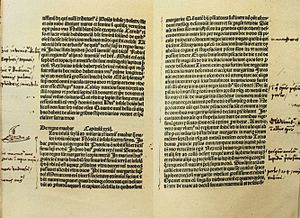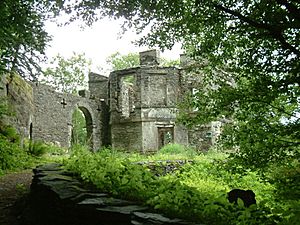Travel literature facts for kids
| Literature |
|---|
 |
| Major forms |
| Genres |
| Media |
|
| Techniques |
| History and lists |
|
| Discussion |
|
Travel literature is a type of writing that tells stories about journeys and different places. It includes many kinds of books and articles, like outdoor adventure stories, guide books that help you explore, writing about nature, and personal stories (called memoirs) about trips.
One of the first people to write about his travels in Western history was Pausanias. He was a Greek geographer who lived a long time ago, around the 2nd century CE. Later, in the 1700s, James Boswell wrote Journal of a Tour to the Hebrides, which helped make travel memoirs a popular type of writing.
Contents
Exploring the History of Travel Stories

People have been writing about their travels for a very long time! Some of the earliest travel stories include the Periplus of the Erythraean Sea from the 1st century CE. This book described sea routes and trading ports. Pausanias also wrote Description of Greece in the 2nd century CE, telling all about Greece.
Other famous early travelers who wrote about their adventures were Nasir Khusraw (who wrote Safarnama), Gerald of Wales (who wrote about Wales), Ibn Jubayr, Marco Polo, and Ibn Battuta. These writers shared amazing details about the places they visited around the world. Even in ancient times, writers like Lucian of Samosata talked about travel writers who added exciting, made-up stories to their real journeys. Travel writing was also very common in Arabic literature during the Middle Ages.
Travel Writing in China
In China, a type of writing called 'travel record literature' became very popular during the Song dynasty (960–1279). Writers like Fan Chengda and Xu Xiake included lots of information about the land and its features in their books. The famous poet Su Shi wrote Record of Stone Bell Mountain, which was a short trip essay that shared deep thoughts and lessons. Chinese travel stories from this time were written in many ways, like narratives, prose, essays, and diaries. Zhou Daguan's story about Cambodia in the 1200s is a key source of information about the ancient city of Angkor.
Early European Travel for Fun
One of the first times someone wrote about traveling just for fun was when Petrarch climbed Mont Ventoux in 1336. He said he went to the top of the mountain simply to enjoy the view. He even wrote about how climbing the mountain was like making progress in his own life.
Other early European travelers also shared their feelings. Michault Taillevent, a poet, traveled through the Jura Mountains in 1430. He wrote about how scared he was by the huge rock faces and loud mountain streams. Antoine de la Sale climbed a volcano in 1407 and shared his thoughts, saying he went for "councils of mad youth." In the mid-1400s, Gilles le Bouvier explained why he wrote his travel book:
Because many people of diverse nations and countries delight and take pleasure, as I have done in times past, in seeing the world and things therein, and also because many wish to know without going there, and others wish to see, go, and travel, I have begun this little book.
Travel Stories Become Common
By the 1500s, stories about trips to India and Persia were so common that they were put into collections. Books like Novus Orbis ("New World") and collections by Ramusio and Richard Hakluyt gathered these tales. Many people traveled Europe too, writing about old buildings and important places.
In the 1700s, travel literature was often called "books of travels." These were mostly diaries from sea voyages. Travel books were very popular in Britain, and many famous writers tried their hand at them. Gulliver's Travels (1726) is a funny story that copied the style of travel books. Captain James Cook's diaries (1784) were huge best-sellers, like today's popular books. Alexander von Humboldt's book about his travels in America (1799–1804) was translated into many languages and inspired later scientists, including Charles Darwin.
Later, stories about the Grand Tour became popular. This was when rich people traveled around Europe to learn about art and old buildings. Robert Louis Stevenson (1850–1894) was a pioneer in tourism writing. His books, An Inland Voyage (1878) and Travels with a Donkey in the Cévennes (1879), were some of the first to make hiking and camping seem like fun activities. He even wrote about ordering one of the first sleeping bags!
Other important travel writers in the 1800s included the Russian Ivan Goncharov, who wrote about his trip around the world, and Lafcadio Hearn, who wrote about Japanese culture. The time between the two World Wars (the 1900s) was a great time for travel literature. Many famous writers like Graham Greene, Rebecca West, and Evelyn Waugh wrote excellent travel books.
In the late 1900s, travel writing became even more popular, especially in English-speaking countries. Writers like Bruce Chatwin, Paul Theroux, and Colin Thubron became well-known. People started studying travel literature in universities, too!
Different Kinds of Travel Books
Travel books come in many styles. Some are like documentaries, full of facts. Others are more like literary stories, or like journalism. They can be personal stories, funny, or very serious. Travel books are often linked to tourism and include guide books. You can find travel writing on websites, in magazines, on blogs, and in books. Many different people write them, including travelers, soldiers, missionaries, explorers, scientists, and teachers.
Travelogues are a special kind of travel story. They mix parts of memoirs, non-fiction facts, and sometimes even fiction to create a story that's about both the trip and what the traveler learned. People have told travel stories throughout history, from ancient explorers to modern blogs and vlogs. In the late 1800s, travelogues became important in newspapers. They often shared many features with short stories, and writers like Henry James and Guy de Maupassant often wrote both travelogues and short stories set in the same places.
Travel and Big Ideas
Travel literature often connects with philosophy or essay writing. For example, V. S. Naipaul's India: A Wounded Civilization (1976) used his trip to India to share deep thoughts about the country and its people. Rebecca West's Black Lamb and Grey Falcon (1941) did something similar about her journey through Yugoslavia. Robin Esrock's books about Canada, Australia, and the world also share his discoveries and thoughts. Even fictional travel stories can do this, like Mark Twain's Adventures of Huckleberry Finn (1884) or Robert M. Pirsig's Zen and the Art of Motorcycle Maintenance (1974).
Sometimes, a writer will stay in one place for a long time. They soak up the feeling of the place while still observing it like a travel writer. Examples include Lawrence Durrell's Bitter Lemons (1957) about Cyprus, Bruce Chatwin's In Patagonia (1977) and The Songlines (1987), and Peter Mayle's best-selling A Year in Provence (1989).
Nature and Travel Writing
Many works combine travel and nature writing. These include books by Sally Carrighar, Gerald Durrell, and Ivan T. Sanderson. Gerald Durrell's My Family and Other Animals (1956) is a funny story about his childhood living with his family on the Greek island of Corfu. It describes the island's animals and his family's adventures. It's the first of his "Corfu trilogy" of books.
Ivan T. Sanderson wrote Animal Treasure about his trip to West Africa, and Caribbean Treasure about his journey to Trinidad, Haiti, and Surinam. These writers are naturalists who write to support their studies of nature.
Another famous naturalist, Charles Darwin, wrote his well-known account of the journey of HMS Beagle. This book mixes science, natural history, and travel.
Famous Writers Who Traveled
Many writers famous for other types of books have also written about their travel experiences. These include Samuel Johnson's A Journey to the Western Islands of Scotland (1775), Charles Dickens' American Notes for General Circulation (1842), Mary Wollstonecraft's Letters Written during a Short Residence in Sweden, Norway, and Denmark (1796), and John Steinbeck's Travels with Charley: In Search of America (1962).
Some modern travel writers are very well-known. These include the Dutch writer Cees Nooteboom, Englishmen Eric Newby and H. V. Morton, and Americans Bill Bryson and Paul Theroux. The Welsh author Jan Morris is also highly praised. Canadian travel writer Robin Esrock has written many books about finding unique experiences in Canada, Australia, and around the world.
Bill Bryson won the Golden Eagle Award in 2011. In 2012, a library at Durham University was named the Bill Bryson Library because of his contributions. Paul Theroux won the Thomas Cook Travel Book Award for his book Riding the Iron Rooster. In 2005, Jan Morris received the Golden PEN Award for her amazing contributions to literature.
It's worth noting that many travel books have been written by men. The French writer Lucie Azema has pointed out that even when women write travel books, their stories can sometimes be forgotten. She believes that male travel writing sometimes gives a one-sided view of the world.
Adventure Travel Stories
Adventure literature is a type of travel writing that focuses on exciting and daring journeys. In the world of sailing, Frank Cowper's Sailing Tours (1892–1896) and Joshua Slocum's Sailing Alone Around the World (1900) are classic adventure stories.
In April 1895, Joshua Slocum began his journey from Boston, Massachusetts. He wrote about starting his trip like this:
- I had resolved on a voyage around the world, and as the wind on the morning of April 24, 1895 was fair, at noon I weighed anchor, set sail, and filled away from Boston, where the Spray had been moored snugly all winter. ... A thrilling pulse beat high in me. My step was light on deck in the crisp air. I felt there could be no turning back, and that I was engaging in an adventure the meaning of which I thoroughly understood.
More than three years later, Slocum returned home to Newport, Rhode Island. He had sailed all the way around the world by June 27, 1898!
Travel Guide Books

A guide book is a book that gives information about a place. It's made to help visitors or tourists. An early example is Thomas West's guide to the English Lake District, published in 1778. Thomas West, a priest, helped make walking for fun popular with his guide. He wrote that he wanted:
to encourage the taste of visiting the lakes by furnishing the traveller with a Guide; and for that purpose, the writer has here collected and laid before him, all the select stations and points of view, noticed by those authors who have last made the tour of the lakes, verified by his own repeated observations.
He included special "stations" or viewpoints around the lakes. From these spots, tourists could enjoy the beautiful scenery. His book was a big success.
Mariana Starke helped make the standard travel guide popular. This type of book gives information about places to stay, restaurants, transportation, and fun activities. Guide books often include maps and details about the history and culture of a place. There are different kinds of guide books, focusing on things like adventure travel or relaxation. Some are for travelers with different budgets, or for people with specific interests. Travel guides can also be found on travel websites.
Stories of Freedom Journeys
The writings of people who escaped slavery are a special kind of travel literature. These stories, written in the 1700s and 1800s, tell how enslaved people traveled to freedom. They describe how they overcame difficult rules and traditions in the southern United States and the Caribbean. As John Cox explains, "travel was a necessary prelude to the publication of a narrative by a slave, for slavery could not be simultaneously experienced and written." These stories show incredible courage and determination.
A very famous story is Frederick Douglass's Narrative. His journey is a big part of his story, starting with him being forced to travel by his masters and ending with him traveling wherever he chose. Solomon Northup's Twelve Years a Slave is another travel story. He also overcame huge challenges to escape after being kidnapped and enslaved. Harriet Ann Jacobs' Incidents includes her journey to freedom in the North.
Fictional Travel Stories
Some fictional stories are also related to travel literature. Sometimes it's hard to tell if a story is completely made up or based on real events, like the famous travel writings of Marco Polo or John Mandeville. Here are some examples of fictional travel stories based on real journeys:
- Joseph Conrad's Heart of Darkness (1899) came from a real trip Conrad took up the River Congo.
- Jack Kerouac's On the Road (1957) and The Dharma Bums (1958) are fictional stories based on his actual travels across the United States in the 1940s and 1950s.
- Travel writer Kira Salak's novel, The White Mary (2008), is a modern example. It's a fictional story based on a real journey that takes place in Papua New Guinea and the Congo.
Travel Blogs: Modern Travel Stories
In the 2000s, travel literature changed and became a part of social media. This happened with travel blogs. Travel bloggers use personal blogs, Pinterest, Twitter, Facebook, Instagram, and travel websites to share information about their adventures. They also give advice for traveling in certain countries or for traveling in general. Travel blogs were actually some of the first types of blogs, starting in the mid-1990s.
Some well-known travel bloggers include Matthew Kepnes, Johnny Ward, and Drew Binsky.
Awards for Travel Books
There are special awards given each year for travel books. These include the Thomas Cook Travel Book Award (which ran from 1980 to 2004), the Boardman Tasker Prize for Mountain Literature, and the Dolman Best Travel Book Award (which started in 2006). The Lowell Thomas Travel Journalism Awards recognize travel books, guidebooks, and travel stories in magazines, newspapers, websites, and even on TV and radio. The National Outdoor Book Awards also honor travel literature about outdoor adventures.
See also
- Adventure travel
- British Guild of Travel Writers
- Imaginary voyage
- Rihla
- Travel documentary, a documentary film or television program that describes travel
- Travel itinerary
- Travelogues of Palestine
- Letters from several parts of Europe and the East

